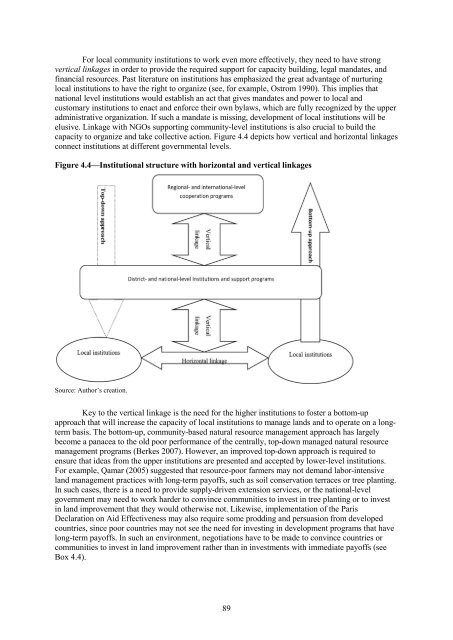The Economics of Desertification, Land Degradation, and Drought
The Economics of Desertification, Land Degradation, and Drought
The Economics of Desertification, Land Degradation, and Drought
Create successful ePaper yourself
Turn your PDF publications into a flip-book with our unique Google optimized e-Paper software.
For local community institutions to work even more effectively, they need to have strong<br />
vertical linkages in order to provide the required support for capacity building, legal m<strong>and</strong>ates, <strong>and</strong><br />
financial resources. Past literature on institutions has emphasized the great advantage <strong>of</strong> nurturing<br />
local institutions to have the right to organize (see, for example, Ostrom 1990). This implies that<br />
national level institutions would establish an act that gives m<strong>and</strong>ates <strong>and</strong> power to local <strong>and</strong><br />
customary institutions to enact <strong>and</strong> enforce their own bylaws, which are fully recognized by the upper<br />
administrative organization. If such a m<strong>and</strong>ate is missing, development <strong>of</strong> local institutions will be<br />
elusive. Linkage with NGOs supporting community-level institutions is also crucial to build the<br />
capacity to organize <strong>and</strong> take collective action. Figure 4.4 depicts how vertical <strong>and</strong> horizontal linkages<br />
connect institutions at different governmental levels.<br />
Figure 4.4—Institutional structure with horizontal <strong>and</strong> vertical linkages<br />
Source: Author’s creation.<br />
Key to the vertical linkage is the need for the higher institutions to foster a bottom-up<br />
approach that will increase the capacity <strong>of</strong> local institutions to manage l<strong>and</strong>s <strong>and</strong> to operate on a longterm<br />
basis. <strong>The</strong> bottom-up, community-based natural resource management approach has largely<br />
become a panacea to the old poor performance <strong>of</strong> the centrally, top-down managed natural resource<br />
management programs (Berkes 2007). However, an improved top-down approach is required to<br />
ensure that ideas from the upper institutions are presented <strong>and</strong> accepted by lower-level institutions.<br />
For example, Qamar (2005) suggested that resource-poor farmers may not dem<strong>and</strong> labor-intensive<br />
l<strong>and</strong> management practices with long-term pay<strong>of</strong>fs, such as soil conservation terraces or tree planting.<br />
In such cases, there is a need to provide supply-driven extension services, or the national-level<br />
government may need to work harder to convince communities to invest in tree planting or to invest<br />
in l<strong>and</strong> improvement that they would otherwise not. Likewise, implementation <strong>of</strong> the Paris<br />
Declaration on Aid Effectiveness may also require some prodding <strong>and</strong> persuasion from developed<br />
countries, since poor countries may not see the need for investing in development programs that have<br />
long-term pay<strong>of</strong>fs. In such an environment, negotiations have to be made to convince countries or<br />
communities to invest in l<strong>and</strong> improvement rather than in investments with immediate pay<strong>of</strong>fs (see<br />
Box 4.4).<br />
89

















